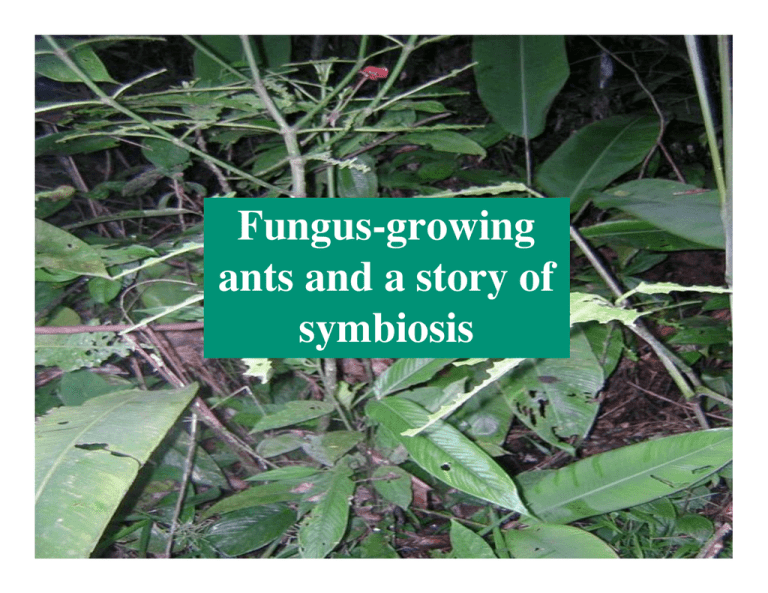Fungus-growing ants and a story of symbiosis
advertisement

Fungus-growing ants and a story of symbiosis Leaf-cutting ants (Tribe: Attini, Genera: Acromyrmex, Atta) • Symbiosis with Fungus - growing their food! • Harvest green leaves to grow fungus –Ants cut up leaves, lick clean, cut to form mulch –Plant matter then covered with fecal droppings –Fungal hyphae placed on top of plant matter –Fecal matter - fertilizer for fungus growth –Fungus digest cellulose into carbohydrates, fats and proteins that the ants can utilize. –Also, part of the fungus is fed to ant larvae Vulnerable to parasites attacking their food source fungal garden! Ecuador (Napo) Can carry 20X their body weight! “Fungus-growing ants use antibioticproducing bacteria to control garden parasites.” Currie et. al Nature 398, 701-4 (1999) Pseudonocardia associated with fungus-growing ants play an important role in this symbiosis of suppressing growth of parasites. Symbiosis • • • • Ants (Attine) Fungal gardens (Lepiotaceae family, Basidiomycotina) Filamentous bacteria (Pseudonocardia) Attacking fungal parasite (Escovopsis) unds o p com g n i t omo r p th Grow antibio tics Originally classified as a “waxy bloom”, or cuticular exudate. Actually, is a mass of filamentous bacteria (actinomycetes)! • 22 species of ants studied from 8 genera • ALL have the actinomycete bacteria • Bacteria located on genus-specific regions of ant integument • Location modified for growth, maintenance, distribution of bacterial metabolites? “Coevolved Crypts and Exocrine Glands Support Mutualistic Bacteria in Fungus-Growing Ants” Currie et. al. Science 311, 81-3 (2006) Housing and Maintenance of the bacteria • Cuticle - exoskeleton • Propleural plates – Fovea - crescent shaped cavity • Bacteria grow in these crypts • Exocrine gland (near fovea, contains duct cells)supports bacterial growth through glandular secretions Transmission? • Before mating flight - 74 queens, 15 males examined – Cuticular actinomycete found on females only • Following mating flight – Cuticular actinomycete found on females only males do not engage in founding new colonies or tending fungal gardens. Transmission through females to daughter nest. Role of bacteria? Pseudonocardia actinomycetes Escovopsis fungal parasite - Pseudonocardia isolates did not inhibit growth of other fungi - Yet, showed inhibitory effects towards Escovopsis, a virulent parasite of Attine ant fungal gardens (zones of inhibition > 30 mm) ing c n a Enh Inhibi tory Growth-promoting effects? - Increase in basidiomycelia biomass in the presence of actinomycetes. - 47.9 ± 7.6 mg dry weight (biomass w/ actinomycete filtrate) - 5.3 ± 2.4 mg dry weight (unamended controls) Conclusions • Bacterial symbiont present in ant/fungal symbiosis • Associated with all Attine ant species and all colonies studied (located in various body regions) • Evolved mutalist – inhibition of Escovopsis – ant provides support Food for Thought • Complexity of symbiosis • Evolution of symbiosis between ants and bacteria to suppress parasites • Microbial regulation of symbiotic relationships • Future studies - chemical interactions between symbionts Questions? Army Ants vs. Leaf-cutters








